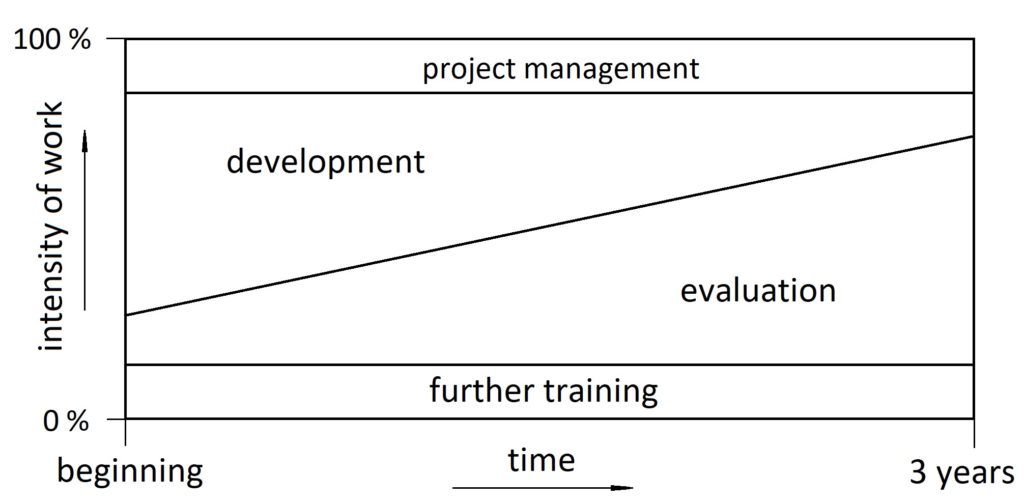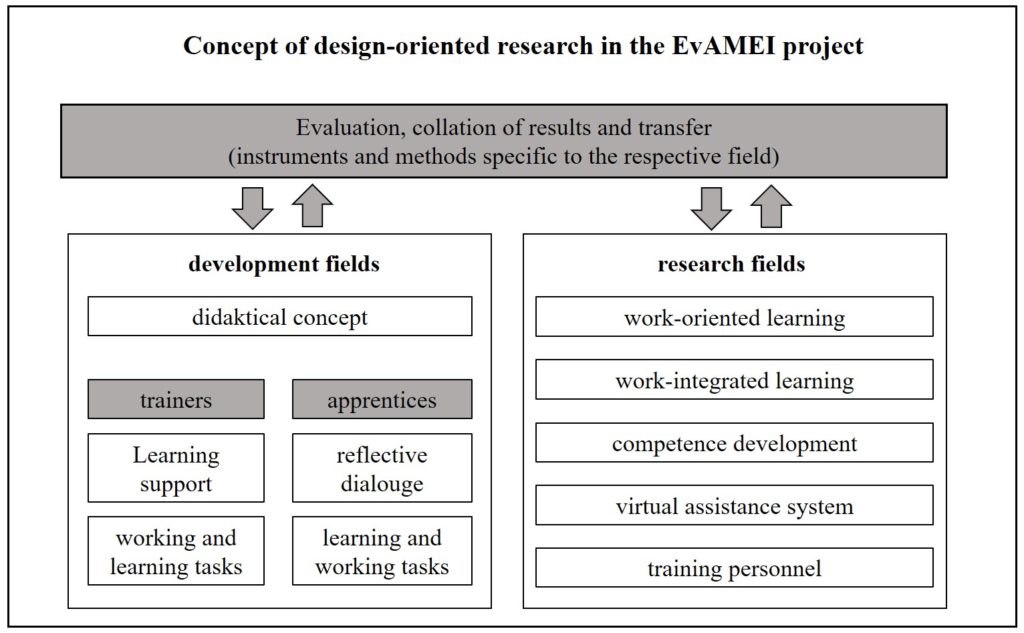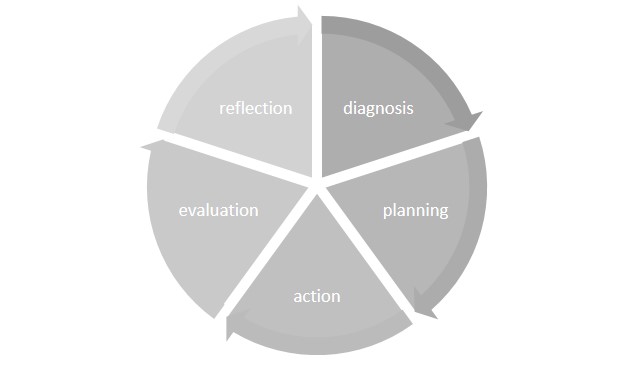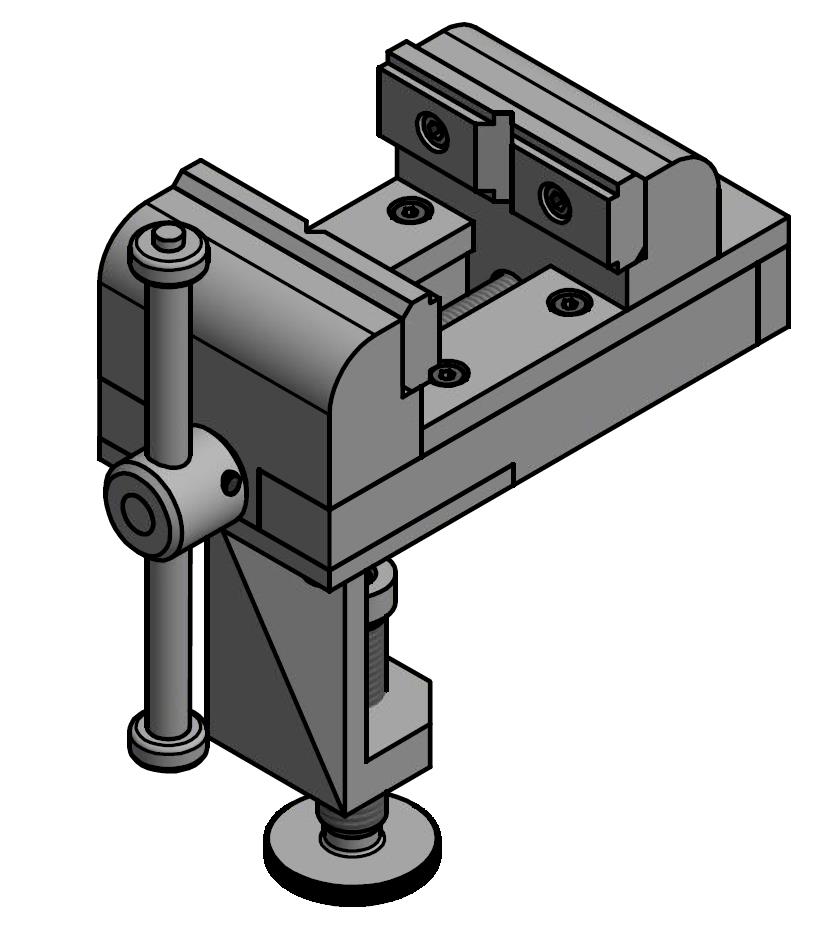Digitisation in TVET must be actively shaped. Digitisation offers opportunities for work-based or work-oriented learning in different learning locations (Schröder & Dehnbostel 2019) and can combine experiential learning in virtual space with the reality of individual competence development (Schröder 2014). In Germany, inter-company vocational training centres (VTC are an important site of learning for dual vocational training. They complement and support in-company vocational training in small and medium-sized enterprises and are considered drivers of innovation for the introduction of new digital technologies. Against this background, digital assistance systems (DAS) should virtually accompany and support trainees’ practical vocational learning in VTC. This article describes the development and testing of DAS as part of the EvAMEI project at the Gemeinschafts-Lehrwerkstatt Arnsberg GmbH (GLW). The aim of DAS is the individual promotion of vocational competences – in this case in the field of mechanical metalworking. Across conceptual, technical and functional levels, the aim is to integrate digital support through DAS into trainees’ practical learning and working processes. The trainers have a dual role here. On the one hand, they function as innovators who actively participate in the development of DAS, contributing their experience and expertise to the design and ultimate implementation of the system in their training practices. On the other hand, they are learners themselves who need to be supported in finding and developing their new role as learning process facilitators and coaches.
Keywords: digital assistance systems, problem-based learning, work-based learning, work-oriented learning, inter-company training centre, digital devices
1 The in-company trainer in Dual TVET Systems and digitalisation
A central criterion of the dual system of vocational training is its functionally differentiated learning venues (Spöttl 2016; Schröder & Dehnbostel 2020). The learning venues are the company workplace, the training centre for practical vocational training, and the vocational school. Large companies operate their own in-company training centres, while SMEs operate training centres collectively, usually through the chambers.
70% of training time is spent inside the company or proportionally in the training centre. The training staff consists of highly proficient specialists who have successfully completed a trainer course and examination. In addition to occupational excellence, they are expected to organise competence development processes at the learning venue workplace or pure “skills development” at the training centre on their own responsibility and to lead the trainees to excellent work results in terms of quality and efficiency. Unlike vocational school teacher training, the course lasts only two to three weeks and is based on the Trainer Aptitude Ordinance (AEVO); qualification is certified by the Chamber of Commerce and Industry.
In Germany (population: 83 million), more than 640,000 company-appointed trainers (as of 2019), professionally and personally suitable according to the Vocational Training Law, bear responsibility for the success of in-company training (German Vocational Training Law, BBiG, § 28-30). In addition to working in companies, they also work at inter-company training centres, competence centres or with external training service providers. Their main focus is to ensure the quality of skilled work in an environment which is free from work or time pressures. They are responsible for approximately 1.5 million apprentices. Cross-referencing stipulations of the BBiG, the Federal Institute for Vocational Education and Training (BIBB) distinguishes between four roles for in-company training personnel working in the context of the dual system:
- Training managers manage the entire training of a (large) company for individual occupations or for occupational groups. This is an in-house job title, but not necessarily a responsibility in the sense of the Vocational Training Law (BBiG). Respective vocational qualifications can be very different.
- Full-time instructors work mainly in large companies with training workshops and at training service providers. They usually have an advanced training qualification (master craftsman, technician, specialist).
- Part-time instructors provide training directly at the workplace. They are instructors who match the characteristics as defined by the BBiG. Their (part-time) work in training includes providing workplace experience. In small companies, they may also act as training supervisors.
- Training specialists are employees who provide on-the-job training without themselves being trainers (as defined by the BBiG). They can, for example, also coordinate training in a company department without instructing apprentices themselves.
There is an urgent need for in-company trainers, both full-time and part-time. Without them, in-company or inter-company educational work cannot attain the desired level of quality. Professional career and advancement opportunities, such as the certified training and further education educator and the certified vocational educator, each with a chamber-certified qualification, point to the necessity of professional in-company training and further education (Schröder & Dehnbostel 2021, 12).
In vocational schools, apprentices spend 30% of their time being taught by vocational school teachers. Instruction is theoretically oriented, but is based on work processes which are typical of the respective occupation. In addition to teaching vocational knowledge and skills, the vocational school focusses on the learning individual and prepares students for lifelong learning. Learning at the vocational school follows a holistic concept of competence; the learner is to become an independent and responsible actor in civil society. Vocational school teachers require a one-year company internship, a bachelor’s and a master’s degree, and an 18-month trainee phase at a vocational school.
Digitalisation is fundamentally changing the job profile of company and inter-company trainers. Digital media is on the increase as a form of learning at the learning venues of companies (work-based learning) and inter-company training centres (work-oriented learning) (Dehnbostel & Schröder 2017; Schröder & Dehnbostel 2021). This paper presents a digital assistance system (DAS) for inter-company training that is currently being developed and tested at the Gemeinschafts-Lehrwerkstatt Arnsberg GmbH (GLW). The UNESCO Chair for TVET, Competence Development and the Future of Work at the TU Dortmund University is accompanying the project, which is first presented in terms of its intentions and goals (2). Then, the concept and structure of the design-oriented accompanying research will be discussed (3), followed by initial results (4). Finally, a conclusion is formulated, as far as this is already possible (5).
2 The EvAMEI project
The EvAMEI project (Use of virtual systems for the accompanying support of apprentices in the metal and electrical industry) is integrated in the national KomZet (Competence Centre) programme to promote the development of inter-company vocational training centres towards competence centres (BMBF & BMWi 2015, 1 f.).
The quality of training in the inter-company vocational training centres (VTC) is to be secured for the future in view of constantly changing technical, economic and social conditions. This requires considerable investment in furnishing training workshops with digital devices and equipment. The funding of technical upgrades is also intended to develop a technical-innovative focus of expertise from which other centres of excellence can benefit. In the case of GLW Arnsberg, the focus is on the development of DAS, although KomZet funding is tied to a further nine mandatory fields of action that the VTC must help to develop concurrently. These include the vocational-pedagogical modernisation of support concepts and appropriate further coaching of training staff with regard to contemporary teaching and learning concepts. Instructors are actively involved in project development and are supported in introducing new training methods into their everyday practice.
An inter-company vocational training centre for over 80 years, the joint apprentice workshop GLW Arnsberg offers basic and specialised courses for apprentices of small and medium-sized companies in metal and electrical industries across the region. Digitisation is associated with high expectations for improving quality and efficiency in training processes. The increasing relevance of digital media is thus apparent not only in (school) learning venues, but also in the (inter)company workplace. Tablet computers provide a constructive and learning-friendly form of communication between man and machine. Through the EvAMEI KomZet project, GLW is being developed into a competence centre for “human-machine interaction” and represents this focus for knowledge transfer in the network of competence centres on a national and international level[1]
2.1 Project and development goals
The EvAMEI project aims to develop GLW Arnsberg into a competence centre for DAS, based on work process and competence-oriented vocational pedagogy. The process is based on the development and employment of DAS as well as testing its sustainable implementation in practical training courses. Overarching goals of the project are:
- Supporting individual competence development through holistic learning and work actions in work process-oriented learning.
- Improving individual support by taking into account learning and performance prerequisites and through level-differentiated learning and work tasks.
- Securing and increasing training efficiency by relieving instructors of rule-based routine activities (e.g. frequently asked questions) by means of automation within the framework of the DAS.
- Increasing the attractiveness of training courses through modern, motivational human-machine interaction.
The goal of virtual guidance and support for apprentices in their learning and work processes on the part of the DAS is to promote the development of professional action competencies. Interactive and adaptive learning and work task systems are needed to provide apprentices with systematic, structured support. This begins with an individual degree of didacticisation, which ideally decreases as competence is developed. At the same time, this increases apprentices’ scope for decision-making and action. This systematically promotes independence, problem-solving skills and learning competence for informal learning, so that apprentices can master new types of action situations.
The DAS is therefore not to be understood as an instructional tool. Rather, it is intended to support apprentices in their work on machine tools …
… to analyse work orders independently and to research the necessary information from various sources.
… to organise orders and plan execution and quality assurance. This includes the appropriate selection of the tools, measuring and auxiliary equipment to be used, setting process parameters, deciding on processes and work steps, establishing relevant quality criteria.
… to inspect manufactured products on the basis of professional objective quality criteria and to evaluate the results; this includes error analysis and identification of suitable measures.
… to reflect on and document learning and work processes and their learning outcomes. These include linking decisions and processes back to their respective theoretical knowledge base, externalising experiences generated, assessing personal goal achievement, developing and assessing alternative solutions, formulating new goals.
2.2 Target groups and partners
The primary target groups are inter-company vocational training centres, but also external vocational training centres and in-house training centres of large industrial companies. Apprentices and instructors should benefit equally from media technology innovations. Apprentices are thus supported in all phases of learning and working activities by digital structuring aids and contents. At the same time, the DAS relieves instructors by taking over parts of the instruction that can be automated, such as clarifying frequently asked questions. Communication becomes more efficient as DAS helps to concretise problems and offers the possibility to access automatically generated process protocols. User-friendly software tools enable instructors to develop new learning and work tasks independently, and to integrate, adapt or expand associated media. Uniform and reusable structural templates help the process. In this way, small, flexible libraries of different teaching & learning arrangements are built, which can be tested, evaluated and exchanged. DAS is potentially part of a corporate knowledge management system. In all cases, apprentices should be the first to benefit, hence didactic, methodological, media and organisational aspects have all been developed from the perspective of the learners.
GLW Arnsberg is supported in the development and implementation of the DAS by two partners. The Department of Industrial Automation at the Fraunhofer Institute of Optronics, System Technologies and Image Exploitation (IOSB-INA) is in charge of technical and functional development of DAS system architecture, software development, and hardware configuration. The role of the TU Dortmund partner university has already been mentioned in part: vocational pedagogical support, especially in course development, scientific evaluation including quality assurance, implementation of competence assessment procedures as well as qualification of training personnel. The next chapter goes into more detail about the contours of the accompanying research.
3 Action and Design-Based Research Approach
The action and design-based research and development approach of the TU Dortmund is based on the principles of the action research method reaching back to Kurt Lewin (1951). According to this approach, research should work with practical hypotheses and always strive for meaningful changes in the social field. Put simply, research should be accompanied by practical action and lead to reforms and qualitative improvements in cooperation with practitioners. In line with Kurt Lewin, development and research activities in the EvAMEI project are interdependent via iteration loops. This results, on the one hand, in a cyclical-recursive design of the research process and, on the other hand, in a shift of emphasis over time in the fields of tasks and activities.
3.1 Variation in focus and cyclical-recursive research processes
At the beginning of the project, the focus tends to be on the development perspective; later, evaluation of measures’ effectiveness and efficiency gain importance (see Figure 1).

Lessons learned must be regularly reflected and fed back into the development process, where they must be taken into account. In principle, it must be ensured that the weighting of the conceptual-developmental part is not at the expense of the evaluative-research part.
It must be assumed that field-specific development and research design, on which the cooperation between TU Dortmund, GLW and IOSB-INA is based, must be further developed and adapted by the partners in the course of the project to modified goals and framework conditions. This requires intensive communicative exchange between all project actors in order to create transparent feedback from the results of ongoing evaluation. Objectives are changed, reweighted or corrected in open dialogue. Teaching concept developments are accompanied scientifically in an advisory capacity. Any resulting changes in action again become the object of investigation.
This recursiveness between action and accompanying research tends to blur the dividing line between researchers and practitioners, which can lead to undesirable consequences in terms of cooperation. As science and practice have different reference points, action systems and objectives, equality is not embedded in the EvAMEI project. A strict separation of consultation in practice and research evaluation is not always given by the interventions in the field and the close cooperation with the GLW, but is achieved and maintained through the distribution of roles within the scientific monitoring process.

In practice, advisory support and evaluation overlap. However, in order to avoid mixing, the different roles must be clearly distinguished: diagnosis, consultation, implementation in accompanying research and evaluation. This avoids unintended influence. The distribution of tasks and roles for scientific support varies over time. Development and research activities are interdependent via iteration loops; action research appears as a cyclical process:

The cyclical process begins with an initial diagnosis (stocktaking) based on work process analysis. This is followed by joint action planning, in this case the definition of elements in personnel and course development. A trial phase or (action implementation) is followed by the evaluation of the courses and personnel development using instruments of qualitative research. Reflection as a basis for new diagnosis completes the cycle. Various quantitative and qualitative methods are used at different stages. The focus is on the latter, because qualitative methods promote communicative validation as well as traceability. Table 1 shows the instruments used according to research topic:
Table1: Survey methods and research topics
| A | B | C | D | |
| Work-oriented learning & learning in the process of work | X | X | X | X |
| Competence development | X | |||
| Virtual assistance systems | X | X | X | |
| Understanding the role of educational personnel | X |
3.2 Didactic concept
The development and implementation of DAS are associated with a didactic and methodological paradigm shift. Where instructional and sequential teaching dominated in traditional training workshops, there should now be a shift to contemporary action and competence-oriented learning approaches[2]. The development of vocational action competence takes place here with work-oriented learning and work tasks, selected on the basis of their occupational type and criteria of competence promotion (holism, complexity, problem content) (Howe 2001, 126 ff.; Franke 1999; Schröder 2009). In the case of inter-company vocational training centres, didactic-methodical implementation is aligned with work-process-oriented approaches (Becker 2013, 7 ff.). Figure 4, based on the action-oriented learning concept of Jank & Mayer (2014, 314 ff.), shows how – a model of the complete action serves as a structure-forming element for the organisation and sequence of the learning and work processes:

The description of the task (A) acts as an initiating impulse for the apprentices, often in the form of a fictitious company order. They analyse the assignment and determine its goal (E): manufacturing a product, advising a customer, planning a production process. Work-related goals are related to competence goals: e.g. to initiate active planning (B), which enables independent processing of the task (A) and evaluation of the action product (E). Unpredictable problems (C) arising in the learning and working process are directly linked to the prescribed competence goals. Apprentices take the initiative (D) when they specifically adopt provided inputs, for example by using materials or tools. Linking experience gained to the content of learning and work tasks in the context of reflection (F) is particularly important. DAS can provide informational support with the data logged in the process, offering a guide to reflection with targeted questions. Subsequently, instructors can make their apprentices aware of implicit action knowledge, fix competence development and agree on further training steps in a reflective discussion.
3.3 Qualification of the instructors
With the introduction of DAS, apprentices and instructors take on a new role. Control is increasingly shifting from the instructors to the apprentices. Learning and work processes are becoming more open and more complex. “Synchronisation” of all apprentices is being abandoned in favour of individual competence development, creating new demands. Experience shows that instructors find it difficult to let their apprentices “run on their own”, especially where technical errors are likely. However, as long as no real damage is to be expected, wrong decisions do not necessarily have to be avoided from the outset. Mistakes are also learning opportunities in reflective conversations. But content and knowledge transfer, along with cognitive support for skills development, are now increasingly being handled by digital tools. For instructors, the accompanying and advising role thus becomes more relevant (Rohs & Käpplinger 2004), as does the tracking of processes on the machine by digital means. In addition, joint introduction at the beginning and individual reflection at the end of each learning and work task take on greater significance. Digital technologies function both as learning and working tools (Euler & Wilbers 2020, 428).
The methodological-didactic changes related to new media such as DAS necessitate further training for instructors, essentially as “learning in the process of work” (Dehnbostel 2007). The real work of the instructors is the constitutive element. Their experience-based competence development in the context of work-integrated learning is illustrated in Figure 4. One difference here is that learning does not take place in simulated work assignments, but within real work situations (A). Coaches and instructors can agree in advance on testing new training practices which can be reflected upon afterwards. In the course of work and learning processes, new challenges and unfamiliar situations inevitably arise (C). These represent crucial learning opportunities and provide scope for new inputs (D). In the EvAMEI project, the support and resources needed for personal development can be determined in individual reflection meetings with the coach.
4 Interim reports from the EvAMEI project
Now that the didactic-methodological and technical-functional parts have been combined, the EvAMEI project has entered the second phase of practical testing and implementation of the overall system in current training courses. Although the project is only in the second of three test phases, experiences and findings can be recorded in short interim reports.
4.1 Software development as an interdisciplinary task
DAS development places high demands on communication between experts from the disciplines of information technology, vocational pedagogy and mechanical or manufacturing engineering. Before software development began, the exchange of requirements, especially of a vocational pedagogical nature, was of fundamental importance. The system should support apprentices in their learning and working processes in such a way that competence is enhanced. The potential danger of instructionism inherent in technology had to be overcome; another risk lay in preferring what was technically possible to what made sense from a didactic point of view. A wealth of information-technological possibilities can lean towards automated decision-making processes to the detriment of situations conducive to learning. However, designing human-machine interaction to enhance competence requires the systematic transfer of control of learning and work processes to the apprentice. DAS can support these decision-making processes by providing information and reflection. Intensive communicative processes between the partners are needed to address all of these requirements in software development.
4.2 Instructors programme virtual learning and work tasks
The learning and work tasks of the DAS were to be freely designed and adapted in terms of content by the instructors themselves using simple means. The goal was to give apprentices assignments, information, and latitude in individual decision-making and action latitude individually, based on a desired level of requirements. Structural openness and freedom of design, however, make user-friendliness more difficult. Learning and work programmes had to be programmable even by non-IT specialists. IOSB-INA developed a so-called node editor which helps instructors to design, organise, monitor, evaluate and maintain their teaching and learning arrangements together with the apprentices. New learning and work tasks can be assembled clearly using “drag and drop” techniques. The user selects pre-programmed function modules (nodes) and fills them with media modules such as learning videos, information texts and input or selection fields. After further steps, a media programme sequence successively emerges that accompanies apprentices through their learning and working process on the machines. They receive work assignments, can inform themselves about facts, plan their processing with structural templates and process and evaluate them with the help of automated feedback. Learning and working processes on the part of the apprentices take place via the so-called player, the main user interface for apprentices.
4.3 Networked learning on machine tools
To enable networked learning, machine tool data is exchanged with the DAS. This enables logging of apprentices’ machine settings as a basis for the accompanying competence assessment. The logs support reflection discussions at the end of a learning unit, as well as the comparison of self-assessment and external assessment of learning progress. To facilitate the assessment of performed learning and work actions, target values for all defined operating states of the machines are stored in an internal database. In this way, the DAS can compare the set process parameters and machine control, then report this back to the apprentice, taking didactic criteria into account. Instructors can intervene if it seems didactically reasonable.
4.4 Course developments and organisational problems
Didactic-methodical innovations and the corresponding changes in course operations place organisational demands on companies. It may be necessary to make didactic adjustments to upstream or downstream training modules. This also affects the departments responsible for planning and coordinating training courses. This is one reason why transparent communication between project actors and acceptance of the project throughout the company is so important. An example of this is the cooperation between the turning and milling training courses. As an industry-oriented VTC, the courses offered by GLW are structured in basic modules. This is intended to enable the relatively large partner companies to take advantage of courses independently of one another and according to the individual needs of their apprentices. However, this form of organisation represents a subject-specific separation of courses and leads to isolated and sequenced forms of training in terms of content. Complex and (if possible) holistic learning and work tasks are now, however, transverse to the various subject areas, so that realistic and operationally relevant work processes presuppose a dissolution of boundaries between courses. This, in turn, may run counter to their marketing as independent modules. One possible solution was to develop a common learning and work task system for the turning and milling courses, among others, leading to a common action product. A parallel vice for the workbench with a span of approx. 60 mm was constructed (Figure 5), which can also be completed by apprentices who do not attend both courses. To this end, duplicate components can be exchanged across courses, whereby the majority of GLW apprentices attend both courses anyway.

While the milling course should be completed in terms of time and didactics by the production of the milled parts of the vice, three further learning and work task systems are planned for the turning course. The basis for the didactic decisions with regard to technical competence goals – learning prerequisites to be assumed, simplifications to be granted, systematisation of individual learning and work tasks – are detailed work process analyses and associated subject analyses of relevant learning content. Interdisciplinary competence objectives were defined by the instructors taking into account a survey of their partner companies. Respondents were particularly interested in promoting sub-competencies in the area of apprentice independence. Individual subject-specific and interdisciplinary competency goals were defined in grids and operationalised by determining compatible training methods and social forms. As a content-related basis for DAS, this phase seeks to describe the complete learning and work activity of each task currently being developed. Digital learning materials are provided to support this aim.
4.5 Personnel development and the role of instructors
Effecting a complete role change within a finite project period cannot be expected of instructors with many years of experience. It is more a matter of initiating incremental changes in their own practice that will lead to ongoing in-service professionalisation. Work-integrated continuing education for instructors can support this process through workshops, learning process support and reflection discussions by providing tools and methods for self-reflection. The introduction of DAS and, in particular, participative and active co-design on the part of the instructors contributes to the expansion of their vocational pedagogical fields of action. Their active involvement has led to a certain sense of appreciation and motivation with a positive, enduring effect on the quality and transfer of innovations. However, the instructors have to be released from their operational duties on a pro rata basis to participate in project work and may need to be replaced in operating courses.
5 Future potential of the Digital Assistance Systems
Developing and introducing DAS for virtual learning and work task systems for work process-oriented learning in inter-company training involves a considerable amount of work. This is especially true if action and work process-oriented teaching or learning arrangements have yet to be established or tested in the company. In view of current vocational and company requirements, postponing the paradigm shift from sequential to work-process-oriented learning is not an option. The didactic-methodical redesign of the courses during DAS development has proven to be a factor that encourages a rethink of traditional training practices in one’s own company[3], encouraging innovation. Connectivity of DAS could only be ensured through participatory development. The needs and requirements of apprentices and instructors are actively integrated into the design and decision-making processes and placed at the centre of development. Ways have to be found to integrate project-related activities effectively into instructors’ operational work in order to engage them fully in the project.
DAS makes it possible to network training workshops internally and externally, unlocking vast potential for future development. This could include the introduction of an operational knowledge management system that supports the internal transfer of innovations to other courses and departments. New teaching & learning arrangements and associated experiences can be exchanged, reflected upon and evaluated. Data can be shared with partner companies and vocational colleges via external networking. These are new perspectives for cooperation with regard to learning locations. GLW could take on a platform function in its chamber district if it succeeds in channelling data exchange via the DAS. The factual and temporal organisation of the entire training process could be standardised across the various learning venues. Sharing of schedules, deployment plans and learning materials can synchronise training across learning sites, and the establishment of a network of players in vocational training and continuing education can accelerate the transfer of innovations both nationally and internationally. Digital learning and work assignment systems could be exchanged, tested and developed for different training areas with the corresponding software solutions for the respective field of application. Part-time training personnel in small and medium-sized enterprises, would also reap the benefits.
[1] EvAMEI runs from 01.06.2019 to 30.09.2022 and has a total volume of approximately 1.3 million euros. The Federal Institute for Vocational Education and Training (BIBB) is funding the project with funds from the Federal Ministry of Education and Research (BMBF). The state of North Rhine-Westphalia is assuming part of the funding costs from the European Social Fund.
[2] For facets and dimensions of the vocational pedagogical concept of competence, see BMBF (2020) and KMK (2018).
[3] GLW sees great potential for innovation, especially in metal cutting courses, through networking new digital learning media with conventional machine tools.
References
Becker, M. (2013). Arbeitsprozessorientierte Didaktik. In: bwp@ Berufs- und Wirtschaftspädagogik, 24, 1–22. Online: http://www.bwpat.de & ausgabe24 & becker_bwpat24.pdf (retrieved 01.03.2021).
BMBF (2020). Vocational Training Law (BBiG) as amended by the announcement of 4 May 2020. Bonn: Federal Ministry of Education and Research. Online: http://www.lexsoft.de/cgi-bin/lexsoft/justizportal_nrw.cgi?xid=498612,1 (retrieved 22.04.2022).
BMBF & BMWi (2015). Bekanntmachung des Bundesministeriums für Bildung und Forschung und des Bundesministeriums für Wirtschaft und Energie zur Änderung der Gemeinsamen Richtlinien für die Förderung überbetrieblicher Berufsbildungsstätten (ÜBS) und ihrer Weiterentwicklung zu Kompetenzzentren as of 15 January 2015. Online: https://www.bibb.de/dokumente/pdf/a34_gemeinsame__richtlinien_fuer_die__foerderung_ueberbetrieblicher_berufsbildungsstaetten_und_ihrer_weiterentwicklung_zu_kompetenzzentren(1).pdf (retrieved 10.05.2021).
Dehnbostel, P. (2007). Lernen im Prozess der Arbeit. Münster: Waxmann.
Dehnbostel, P. & Schröder, T. (2017). Work-based and Work-related Learning – Models and Learning Concepts. In: TVET@Asia, 9, 1-16. Online: https://tvet-online.asia/issue/9/dehnbostel-schroeder-tvet9/ (retrieved 30.06.2017).
Euler, D. & Wilbers, K. (2020). Berufsbildung in digitalen Lernumgebungen. In: Arnold, R., Lipsmeier, A., & Rohs, M. (eds.): Handbuch Berufsbildung. Wiesbaden: Springer, 427-438.
Franke, G. (1999). Erfahrung und Kompetenzentwicklung. In: Dehnbostel, P., Markert, W., & Novak, H. (eds.): Workshop Erfahrungslernen in der Beruflichen Bildung. Beiträge zu einem Kontroversen Konzept. Hochschultage Berufliche Bildung. Neusäß: Kieser, 54-70.
Hömann, K., Land, M., & Schröder, T. (2022). Entwicklung und Erprobung eines digitalen Assistenzsystems für die berufspraktische Ausbildung. In: Berufsbildung in Wissenschaft und Praxis, 51, 2, 34-36. Online: https://www.bwp-zeitschrift.de/de/bwp.php/de/bwp/show/17799 (retrieved 28.06.2022).
Howe, F. (2001). Gestaltungsorientierte Lern- und Arbeitsaufgaben. In: Ebeling, U.; Gronwald, D. & Stuber, F. (eds.): Lern- und Arbeitsaufgaben als didaktisch-methodisches Konzept. Arbeitsbezogene Lernprozesse in der gewerblich-technischen Ausbildung. Bielefeld: Bertelsmann, 126-146.
Jank, W. & Meyer, H. (2014). Didaktische Modelle. Berlin: Cornelsen.
KMK (2018). Handreichung für die Erarbeitung von Rahmenlehrplänen der Kultusministerkonferenz für den berufsbezogenen Unterricht in der Berufsschule und ihre Abstimmung mit Ausbildungsordnungen des Bundes für anerkannte Ausbildungsberufe. Berlin: Sekretariat der Kultusministerkonferenz (Secretariat of the Standing Conference of the Ministers of Education and Cultural Affairs). Online: https://www.kmk.org/fileadmin/veroeffentlichungen_beschluesse/2021/2021_06_17-GEP-Handreichung.pdf (retrieved 22.04.2022).
Lewin, K. (1951). Field theory in social science. Selected theoretical papers. New York: Harper.
Land, M., Mahrin, B., & Schröder, T. (2021). Neue Perspektiven für überbetriebliche Berufsbildungsstätten durch virtuelle Assistenzsysteme. In: Dehnbostel, P., Richter, G., Schröder, T., & Tisch, A. (eds.): Lernen in der digitalen Transformation der Arbeit. Stuttgart: Schäfer-Poeschl, 237-250.
Molzberger, G. & Schröder, T. (2005). Von der Praxisentwicklung zur Theoriebildung und wieder zurück – Handelnd forschen in einem arbeitsprozessorientierten Qualifizierungsprojekt. In: Weiterbildung – Zeitschrift für Grundlagen, Praxis und Trends. 16, 5, 33-35.
Molzberger, G. & Schröder, T. (2009). Forschungsansatz und Evaluationsinstrumente in ITAQU. In: Molzberger, G., Schröder, T., Dehnbostel, P., & Harder, D. (eds.): Weiterbildung in den betrieblichen Arbeitsprozess integrieren. Erfahrungen und Erkenntnisse in kleinen und mittelständischen Unternehmen. Münster: Waxmann, 85-90.
Rohs, M. & Käpplinger, B. (2004). Lernberatung – ein Omnibusbegriff auf Erfolgstour. In: Rohs, M. & Käpplinger, B. (eds.): Lernberatung in der beruflich-betrieblichen Weiterbildung. Konzepte und Praxisbeispiele für die Umsetzung. Münster: Waxmann, 13-28.
Schröder, T. (2019). A regional approach for the development of TVET systems in the light of the 4th industrial revolution: the regional association of vocational and technical education in Asia. In: International Journal of Training Research, 17, 83-95.
Schröder, T. (2009). Arbeits- und Lernaufgaben für die Weiterbildung. Eine Lernform für das Lernen im Prozess der Arbeit. Bielefeld: Bertelsmann.
Schröder, T. (2014). Didactical Concept of Work-based Training in a Virtual Working Space. In: Journal of US-China Education Review A & B, 4, 7, 441-448.
Schröder, T. & Dehnbostel, P. (2019). Enhancing Permeability between Vocational and Tertiary Education through Corporate Learning. In: McGrath, S., Mulder, M., Papier, J., & Suart, R. (eds.): Handbook of Vocational Education and Training. Cham: Springer, 1-24.
Schröder, T. & Dehnbostel, P. (2020). Unbound Learning Venues and Work Design Conducive to Learning in the Digitalized World of Work. In: Peters, M. & Heraud, R. (eds.): Encyclopedia of Educational Innovation. Singapore: Springer, 1-6.
Schröder, T. & Dehnbostel, P. (2021). The workplace as a place of learning in times of digital transformation – models of work-related and work-based learning and in-company concepts. In: TVET@Asia, 17, 1-16. Online: https://tvet-online.asia/issue/17/the-workplace-as-a-place-of-learning-in-times-of-digital-transformation-models-of-work-related-and-work-based-learning-and-in-company-concepts (retrieved 31.07.2021).
Spöttl, G. (2016). Das Duale System der Berufsausbildung als Leitmodell. Struktur, Organisation und Perspektiven der Entwicklung und europäische Einflüsse. Frankfurt am Main: Peter Lang.
Susman, G. & Evered, R. (1978). An Assessment of the Scientific Merits of Action Research. In: Administrative Science Quarterly, 23, 4, 582-603.




